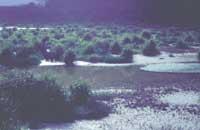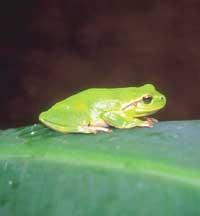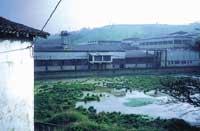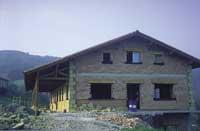The singer-songwriter of the treasure: the southern ranita

Relatively broad species of extension: It is located north and west of Africa, south of the Iberian peninsula and southeast of France. However, the frogs of Euskal Herria appear isolated: In the north of Landeta are the frogs closest to the south. Although no research has been carried out, thanks to this isolation, it is possible that the genotype of frogs of Euskal Herria is relatively special.
The frogs have the erect head, the short and rounded end. The eyes are flanked and expelled, although the buoys are horizontal to the light, they expand in the dark. The eardrums, the center of the diameter of the eye, are very visible. On the front legs have four fingers and on the back five, all equipped with adhesive discs, which allow them to move comfortably through bushes, reeds and trees.
The southern ranita has a similar relative with a wider distribution in the Basque Country: the common ranita (Hyla arborea). Both have a soft, green skin and both have the habit of walking in the trees (yes, in the trees! ). However, they are easily separable, since the normal ranita presents on both sides a black line that arrives from the area of the nose to the anus, while the southern ranita has only black stripes from the area of the nose to the front legs.

Although the normal frog can reach 5 cm, that of the south can reach 5.5 cm. As for the run, the normal is “krak, krak, krak, krak,…” grotesque, while the southern is “kra-r” deep, slow and loud, melody of the spring nights. So with such a special chant you can't hybridize with the normal frog, no!
We will tell you that the best time to see this enclave is spring, around the wells or ponds, which is when it approaches the water, and even if they did not get it, you would surely hear it. The males run aloud forming choirs, each occupying a strategic place (often a floating plant) and inflating the sacks of the mouth, to impress the females.
The rest of the inhabitants of the territory, who approach less than a meter, are threatened. In addition to these two currents, two others have been described: the one that is usually performed when a physical contact occurs with another male, known as a contact belt, and the one that is carried out between intermediates, threat and call corrals.
The call belt can start at dusk and last until the first hour of the morning. The reproductive season is 3 months, from February to April. Many amuros have a short time of laying, while the southern ranita usually lengthen three months.
The laying will begin a few hours after the equalization, which can produce between 500 and 1,000 eggs between aquatic plants. One of the biggest problems for the reproduction of this frog is to find an adequate aquatic vegetation. As in the rest of the frogs, the aquatic larvae called swords or bilinbols will come out. After metamorphosis, the adult appears, that is, the frog itself. The larvae feed both flowers and algae and adults are insectivores, like beetles, flies and butterflies. These frogs hibernate in the cracks of the stones.

Being a subtropical species, the location of Mendizorrotz can be considered rare, making this frog even more special, go treasure! Don't you think? Perhaps due to the influence of the sea, the climate is the reason for this distribution.
The situation of this ranita is worrying, we do not know how many specimens there are, but they are few. This unfortunate situation is explained for several reasons: the fires that occur from time to time are highly harmful to our favorite ranita, since in addition to burning the trees and bushes in which it lives, the frog itself could kill it. The destruction of the surrounding vegetation causes a decrease in the reproductive success, since the eggs are placed there. The construction of houses frequently causes the disappearance of wells, in addition to the increasing mortality of frogs on the roads.
On the other hand, people, “with good will”, usually throw fish and crabs into the wells without realizing that the consequences of these actions can be serious, that being predators cause great damage, destroying the populations of frog. In addition, if we add the delicate situation of amphibians around the world (which many scientists associate with complex climate changes), we will realize that, in addition to leaving them alone, we must give them a push. Remember that it is the only threatened amphibian of Euskal Herria!

And since most of the damage is caused by the man, we have to solve this situation, protecting the wells, taking measures against pollution, protecting the vegetation of these wells and taking into account the location of these wells in the construction of the houses. The construction of new wells would also be adequate, although the conditions of these artificial wells should be adequate to carry out the reproductive processes.
To deal with the problem of roads it would be useful to take steps below the road and return to the store the fish of the house when we do not know what to do. If the conditions necessary for the survival of the frog were carried out, the possibilities of maintaining the populations would be high. The current situation is dead or intense and would suffice with a little will for this pride that we consider a treasure to last in our territories. Many spring we will be able to hear your particular strap!
To end a curiosity: Part of Mount Mendizorrotz is Igeldo, where does his name come from? Will it be for the southern ranita?
Southern Ranita
Species: Hyla meridionalis Family:hylidae Order:anfere Class:amphibians
Buletina
Bidali zure helbide elektronikoa eta jaso asteroko buletina zure sarrera-ontzian











